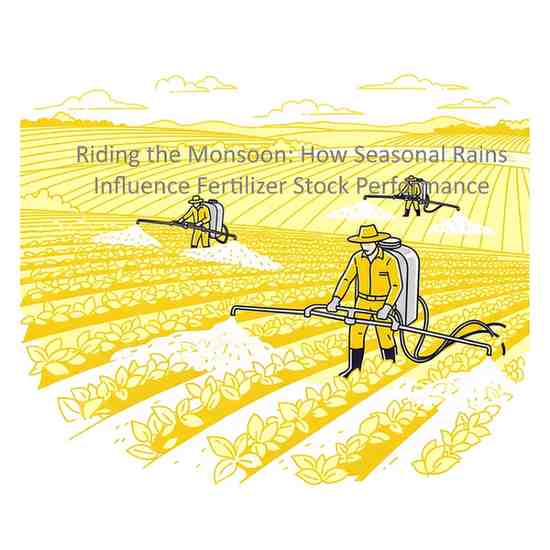
Riding the Monsoon: How Seasonal Rains Influence Fertilizer Stock Performance
Riding the Monsoon: How Seasonal Rains Influence Fertilizer Stock Performance
As we find ourselves in the heart of July 2025, the performance of the Southwest Monsoon is more than just a subject of daily conversation across India; it is a critical variable watched with keen interest in the corridors of Dalal Street. The seasonal rains have long been dubbed the nation’s ‘real finance minister’, and for good reason. Their performance dictates the fortunes of the agricultural sector, which in turn creates a significant ripple effect across the entire economy. For investors, understanding this cascade is key to identifying seasonal investment themes, and few sectors are as directly correlated with the monsoon’s vigour as the fertilizer industry.
Thank you for reading this post, don't forget to subscribe!This analysis delves into the intricate relationship between seasonal rainfall and the financial performance of fertilizer companies. We will explore the mechanisms driving this connection, from macroeconomic implications to on-the-ground demand dynamics. For investors seeking to comprehend the nuances of the monsoon effect on fertilizer stocks, this examination provides a framework for informed analysis, moving beyond simplistic correlations to a more structured understanding of the opportunities and risks involved.
The Foundational Link: Impact of Monsoon on the Indian Economy
To appreciate the movement in specific stocks, one must first grasp the macroeconomic canvas that the monsoon paints each year. The impact of monsoon on Indian economy is multifaceted and profound. With nearly half of India’s population dependent on agriculture for its livelihood and a significant portion of its farmland being rain-fed, a normal or above-normal monsoon acts as a powerful economic stimulant.
A healthy monsoon directly boosts rural incomes by ensuring robust crop yields for the crucial Kharif (summer) sowing season. This surge in disposable income fuels rural consumption, driving demand for everything from FMCG products to two-wheelers and tractors. Furthermore, abundant agricultural output helps to keep food inflation in check, providing the Reserve Bank of India (RBI) with greater flexibility in its monetary policy decisions. Conversely, a deficient monsoon can trigger rural distress, stoke inflation, and dampen the nation’s GDP growth. This overarching economic sensitivity is the primary reason why market participants from all sectors track meteorological forecasts with such intensity.
From Rain Clouds to Revenue Streams: The Agricultural Value Chain
The direct beneficiary of timely and well-distributed rainfall is, naturally, the agricultural sector. The performance of the monsoon is the principal determinant of sowing decisions made by millions of farmers for the Kharif season, which typically accounts for about half of India’s annual food grain production.
The sequence is logical and direct:
- Positive Monsoon Forecast: An optimistic forecast from the India Meteorological Department (IMD) encourages farmers to increase the acreage under cultivation.
- Sustained Rainfall: Adequate rainfall during the sowing and subsequent growth periods ensures soil moisture, which is essential for crop health and yield.
- Increased Input Demand: Higher sowing and the pursuit of better yields lead to a direct and immediate increase in the demand for critical farm inputs: seeds, pesticides, and, most importantly, fertilizers.
This is where the financial prospects of fertilizer stocks in India become intrinsically linked to the patterns of rainfall. A good monsoon season is a powerful demand driver for fertilizer products like Urea, Di-Ammonium Phosphate (DAP), and various NPK (Nitrogen, Phosphorus, and Potassium) complexes.
Fertilizer Stocks: A Direct Proxy for Monsoon Performance
While many sectors benefit indirectly from a good monsoon through a general economic uplift, fertilizer companies are on the front line, experiencing the demand shift almost immediately. The correlation stems from the direct impact of rainfall on soil nutrient requirements and application schedules.
When rainfall is adequate, farmers are more confident in investing in their crops, leading to higher fertilizer application to maximise output. This translates into higher sales volumes for fertilizer manufacturers and distributors. The financial statements of these companies often reflect this seasonality, with the quarters covering the Kharif and Rabi (winter) sowing seasons (Q2 and Q3 of the financial year) being particularly significant.
However, an informed investor must look beyond the headline correlation. Several other factors mediate this relationship:
- Government Policy: The fertilizer sector in India is heavily regulated. The government fixes the price of Urea for farmers and provides subsidies to manufacturers to cover the gap between production cost and sale price. The timeliness and adequacy of these subsidy payments are critical for the working capital cycle and profitability of these companies.
- Raw Material Costs: The profitability of non-Urea fertilizer producers is sensitive to global prices of raw materials like phosphoric acid, ammonia, and potash, which are largely imported. A favourable monsoon might boost sales volumes, but high input costs can still pressure margins.
- Channel Inventory: It is important to assess the level of inventory already present in the sales channel before the season begins. If distributors are sitting on high levels of unsold stock from the previous season, new sales from manufacturers may be subdued even in a good monsoon year.
Analytical Framework for Evaluating Agriculture Stocks Performance
Investors looking for potential monsoon stocks to buy should adopt a multi-faceted analytical approach rather than simply acting on rainfall forecasts. When evaluating the agriculture stocks performance, particularly within the fertilizer space, consider the following:
- Spatial and Temporal Distribution of Rain: A strong national average for the monsoon can be misleading. It is the geographical and temporal spread that matters. A deficit in key agricultural states like Uttar Pradesh, Punjab, or Maharashtra can have a material impact on fertilizer sales, even if the nationwide figure is normal. As of mid-July 2025, tracking this regional distribution is more critical than looking at the aggregate forecast.
- Company’s Product Portfolio: Differentiate between companies. Is the company primarily a Urea producer, dependent on fixed subsidies, or does it have a strong position in complex, non-subsidised fertilizers where it has better pricing power? A diversified product mix can offer resilience.
- Balance Sheet Strength: Examine debt levels and the working capital cycle. Companies with high debt or those perennially awaiting large subsidy receivables may be less equipped to benefit from a demand upswing.
Conclusion
The connection between the Indian monsoon and the performance of fertilizer stocks is undeniable and forms a cornerstone of seasonal investing strategies in the country. A bountiful monsoon reliably translates into heightened agricultural activity, acting as a direct catalyst for fertilizer demand.
However, for the discerning investor, this relationship is the starting point of analysis, not the conclusion. A comprehensive evaluation must incorporate the specifics of rainfall distribution, the prevailing government policy landscape, global raw material price trends, and the fundamental financial health of the companies in question. By integrating these macroeconomic and microeconomic factors, an investor can move beyond riding the monsoon wave to navigating it with strategic foresight, making informed decisions that are grounded in thorough research rather than just seasonal sentiment.
Related Blogs:
Best Fertilizer Stocks in India
5 Best Chemical Stocks for Long-Term Investment in India
Top 5 Chemical Stocks in India
Best Chemical Stocks in India
Top 5 Oil and Gas Stocks in India
Renewable Energy Stocks: A Core Component of a Robust 2025 Portfolio
Best Green Energy Stocks in India 2025
Top 5 Fertilizer Stocks in India
Best Fertilizer Stocks in India
Best Pharmaceutical Stocks in India
Disclaimer: This blog post is intended for informational purposes only and should not be considered financial advice. The financial data presented is subject to change over time, and the securities mentioned are examples only and do not constitute investment recommendations. Always conduct thorough research and consult with a qualified financial advisor before making any investment decisions.

